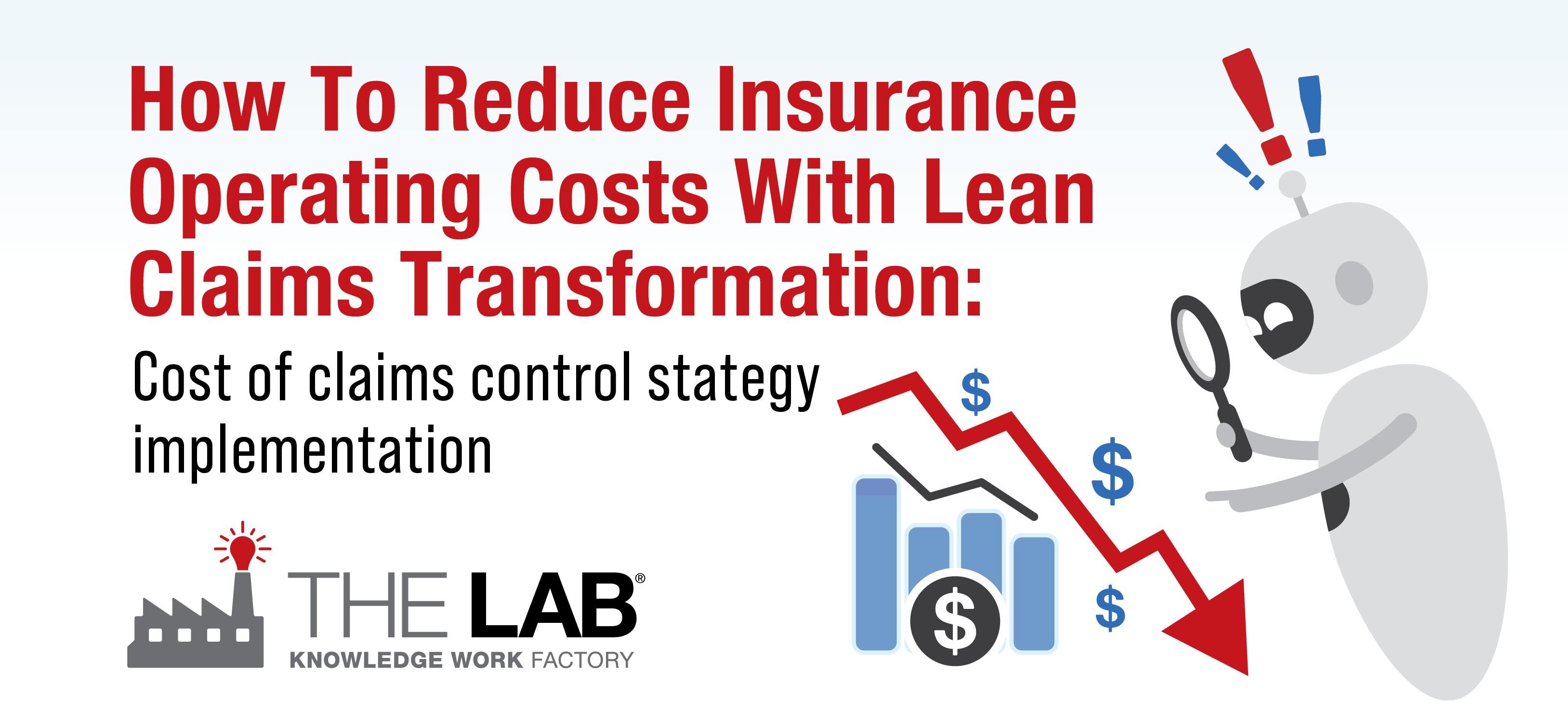Our previous article reviewed the claims leakage reduction project design requirements for an insurance claims transformation project. This article will discuss both the implementation and ongoing improvement, based on The Lab’s lean insurance claims experience with numerous insurance companies across the country. Just as important, we’re going to zero in on some important details, based on actual “war stories,” that can help you to reduce your insurance operating costs.
Are you tasked with reducing and minimizing insurance claims leakage? Find out how to accelerate those efforts here: How to minimize claims leakage in 2020-2021 with bots
Cost of claims control strategy is not what you think
Our first article in this series about successfully reducing insurance operating costs noted that there’s a pervasive bias in the insurance industry against the fast processing of claims. Many believe that it’s as much art as science, and thus fast processors will increase loss severity and not reduce loss ratio.
We’d noted that that’s simply not true. But here, let’s dive into some specific details. We have found that, for most insurance claims-processing operations, the top 75 percent of performers can absorb the volume of all of the processors in the bottom 25 percent. And this can be accomplished via productivity improvements merely in the 10- to 15-percent range! Think about that. Your top 75 percent of people only need to improve about ten percent in order to fully cover the bottom 25 percent. That is the fastest way to reduce the loss ratio in your insurance company.
And what about loss severity? The bottom 25 percent of performers typically produce claims costs that are 50 percent higher than the rest of the group. So they’re not only slower, they’re more costly. In fact, about half of the top 75 percent of your processing team are producing at 1.5 times the rate of your bottom quartile. It’s a glaring variance and insight into insurance claims transformation opportunities.
Now, since we’re talking about “implementation” of a cost-of-claims control strategy here, we can, happily, give you the good news. Taking advantage of the insurance claims process improvements which we design (see previous article), we often find that 80 percent of a company’s adjusting staff will improve. And 85 percent of the lowest-performing group improves, too.
A lot of it comes down to visibility into the claims value stream. In many companies, we find that the lowest performers don’t realize they’re the lowest performers. They need to be told (we often help clients generate a “naughty list”), and need to be held accountable. Simply giving them a goal can make all the difference.
By the way, claims process improvements can be both pervasive and fast. For many of our insurance transformation projects, we’ll find that, as we proceed, the top-performing teams will be the ones consisting largely of new hires. They’re often 100-percent compliant. Why? They never had any bad habits to un-learn, or baggage to discard.
Reducing insurance operating costs with lean principles: Transparency vs. excuses
Many insurance claims-operations managers are understandably proud of their teams. And they’ll tell you that they know how each person performs. Some, in fact, can get defensive when the prospect of individual performance metrics looms near: “Don’t you trust me? I know my people!”
But the numbers are a revelation. They shine a spotlight on both the high and low performers. They help managers to get more out of each person on their teams.
This is why it’s vital that upper management supports them, making it clear that improvement, and not excuses, is the goal.
Insurance transformation and cost of claims control strategy: The case of the bloated claims assignment categories
When we implement an insurance claims transformation, we often find process bottlenecks that beg for remediation. Here’s a typical example:
The first-notice-of-loss (FNOL) call-center team has a vital job. Residing at the front end of the insurance claims value stream, they need to quickly and efficiently assign claims. But we’ll often find that they’re overwhelmed by the sheer number of categories they must consider. We find that 50 to 60 categories is not uncommon; the problem is that only half that number is often sufficient.
Take automotive claims, for example. We’ve found separate categories for incidents such as “hit at intersection from the right side” and “hit at intersection from the left side.” Why are those two separate categories? It’s because the wrong people were granted the decision rights, and because no one above them ever bothered to look.
Needless to say, paring down the list of claims categories is a great tool when it comes to successfully reducing insurance operating costs.
Lean principles in insurance: Continuous monitoring and ongoing improvement to reduce cost after claims transformation
So how do you make these new claims approaches stick? While we initially produce the daily dashboards, we transition that task to the client. We’ll go through multiple iterations of knowledge-transfer sessions, using whatever reporting tools the client uses. The goal is to ensure that the new claims management routines become part of the culture.
What, then, are the takeaways for you and your goals of claims operating cost reduction? Know that this is a “game of inches.” There’s always room for improvement, and the small items add up big, at scale. We were recently tasked with finding $25 million in lean non-technology improvements at an insurer’s claims operations; we ended up identifying $26 million.
Is your insurance loss ratio the lowest it can be? Is your loss severity suffering from bloat? Consider spending just 30 minutes on the phone with The Lab. In that one call, we can show you how we routinely help with insurance claims transformations as part of a cost-of-claims control strategy, using our world-leading database of improvement templates and irresistible self-funding, money-back-guaranteed engagement model. Contact us now to schedule that no-obligation call today.


















